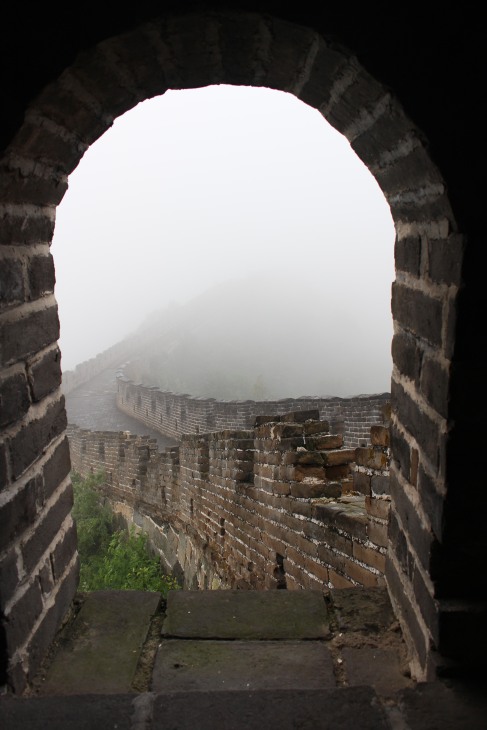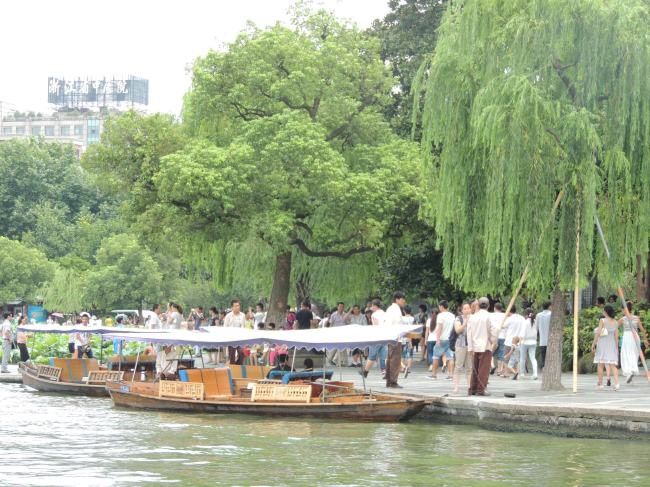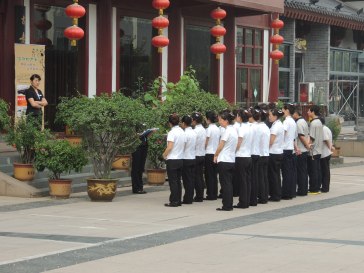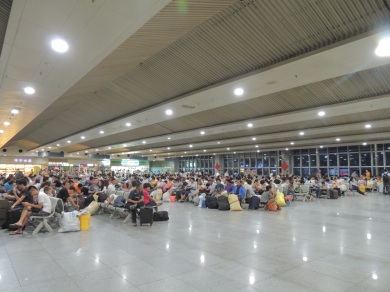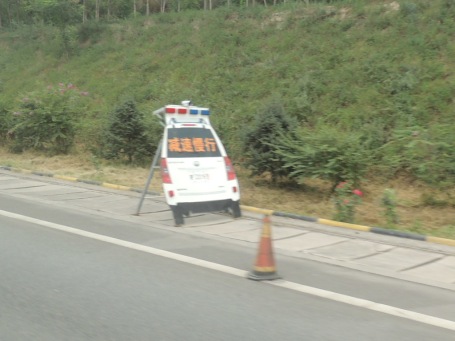We had a three-day weekend this week, and several of us decided to go on a trip to Xian, about 1,400 km away (about 870  miles). To get the full travel experience, we took a sleeper train over on Thursday evening, leaving Shanghai at 10:00 pm (or 22:00, to be precise). I wasn’t sure if I would sleep, but it turns out that the soft clackety-clack of the rails is very sleep-inducing. Apparently the train is pretty quick — Bill woke up early and noted that the speed indicator said we were going about 245 kpm (152 mph), and we weren’t even on a bullet train. We were jarred awake at 7:10 am with very, ah, distinct music greeting us and telling us we were one hour from Xian (pronounced “she-an”)
miles). To get the full travel experience, we took a sleeper train over on Thursday evening, leaving Shanghai at 10:00 pm (or 22:00, to be precise). I wasn’t sure if I would sleep, but it turns out that the soft clackety-clack of the rails is very sleep-inducing. Apparently the train is pretty quick — Bill woke up early and noted that the speed indicator said we were going about 245 kpm (152 mph), and we weren’t even on a bullet train. We were jarred awake at 7:10 am with very, ah, distinct music greeting us and telling us we were one hour from Xian (pronounced “she-an”)
Xian was an eye-opener. I’ve heard of the Terracotta Warriors found in Xian in the mid-70’s, how they were found “in a field” as a farmer was digging a well. That, plus Xian is out in the middle of nowhere, I was anticipating a smaller town, with a more village-y feel.
Uh. No.
Xian has a population of 8 MILLION people. It’s a huge city, with plans to get even bigger, if the building that is frantically going on is any indication. Our tour guide is a native of Xian, and was full of information on how it has grown — but even so, when she was born in the 80’s, the town was about the size of Atlanta, so it’s never been a “village”. In fact, in China, there are over 100 towns with a population of one million or more. I find myself constantly readjusting my view of China, which up to this pointh had been a few big towns and a lot of rice paddies. Uh . . . no.
We stayed at the Westin (fluffy, Western-style beds, THANK YOU, GOD!!), a tub that was a religious experience, a very lovely shower and a TV that had 8 — count ’em, 8! — English langauge stations. Bliss. The breakfast in the mornings was wonderful — all sorts of Western goodies like bacon and waffles, along with all the Chinese standards such as fried noodles, chongee and steamed buns. And the service was impeccable.
Our tour guide had us moving briskly from sight to sight. We visited the City Wall, a tall, ancient wall (think miniature Great Wall) around the center of town which is a rectangle that measures 9 miles along the top ramparts. We walked along the top for a while (about 30-40 feet wide), or, as Bill wryly put it, a la “Blazing Saddles”, “we’re walking the parapets!” That afternoon, we visited a museum that has a well-known collection of calligraphy — many of the ancient Chinese tomes that had been inscribed in stone — as well as many stelae, tall stones that served as monuments or memorials. It was interesting, but I’m afraid the intricacies in the development of Chinese calligraphy over the centuries was somewhat lost on me.
Saturday morning, we visited a Neolithic village that had been discovered in the 1950’s when they started to dig for a power plant. (I feel sorry for contractors around here — it seems like every time they dig a hole in the ground, they come up with some priceless artifact that brings things to a screeching halt as everyone peruses said artifact to see if it’s something significant — or just an old pot.) The Neolithic village showed where the huts had been built, the burial grounds, some remains, and other tools, etc. To the untrained eye (i.e., mine), it looked like a lot of holes in the dirt. OK, so I’ll never be an archeologist . . .
The Terracotta Warriors, on the other hand, were mind-blowing. I knew that they had become a tourist mecca in Xian, but again, my preconceived notions kept me from conceiving just how HUGE a deal this is. Our first hint was the amount of traffic outside of the entrance, and the sheer number of tour buses. HUNDREDS of tour buses. Our van had some sort of special pass, and we were dropped off at the door (which was nice, because the parking lot looked like Six Flags on a bad day). We entered a huge ticket pavillion (they get about 40,000 visitors a day) and our guide quickly ducked into a building and came back, excited — “Mr. Yang is here! You must see him!” Mr. Yang is the farmer who is credited with finding the pottery shards that led to the discovery. Farmers had been finding shards of pottery and pieces of roof tiles in their fields in that area for hundreds of years, buut Mr. Yang is the one who found some significant pieces and brought them to the attention of the authorities — for his trouble, he was paid 30 yuan (about $5 in today’s money). But, he also got a cushy job with the government where he sits at a large table in the air conditioning, greets visitors and autographs a guide book, and earns about $160 a month. He still has the original hoe he used to unearth the first warrior — he uses it to plant flowers around his house.
here! You must see him!” Mr. Yang is the farmer who is credited with finding the pottery shards that led to the discovery. Farmers had been finding shards of pottery and pieces of roof tiles in their fields in that area for hundreds of years, buut Mr. Yang is the one who found some significant pieces and brought them to the attention of the authorities — for his trouble, he was paid 30 yuan (about $5 in today’s money). But, he also got a cushy job with the government where he sits at a large table in the air conditioning, greets visitors and autographs a guide book, and earns about $160 a month. He still has the original hoe he used to unearth the first warrior — he uses it to plant flowers around his house.
The warriors themselves are magnificent. An area about the size of two football fields is enclosed with a building and is part exhibition and part active archeological dig. As they find shards, it takes anywhere from six months to four years to reassemble a life-size warrior — to date, they have about 1,000 warriors reconstructed, and estimate that there are a  total of 6,000 that served as the honor guard to the emperor’s tomb. Other sites, also enclosed show statues of officials, officers, acrobats, etc. — everything to make the emperor feel good in the afterlife. Can you imagine being 13 years old and starting to plan your tomb? It took over 30 years and 700,000 workers to complete. The emperor’s tomb is untouched at this time — there are concerns about mercury poisoning in the soil, since his tomb had a river of mercury surrounding it, to represent a river (good feng shui, apparently.) All the warriors were painted in life-like colors, but the colors faded and flaked off after only 15 minutes exposure to the air after unearthing. Luckily, they have some photos that were taken that show the level of detail.
total of 6,000 that served as the honor guard to the emperor’s tomb. Other sites, also enclosed show statues of officials, officers, acrobats, etc. — everything to make the emperor feel good in the afterlife. Can you imagine being 13 years old and starting to plan your tomb? It took over 30 years and 700,000 workers to complete. The emperor’s tomb is untouched at this time — there are concerns about mercury poisoning in the soil, since his tomb had a river of mercury surrounding it, to represent a river (good feng shui, apparently.) All the warriors were painted in life-like colors, but the colors faded and flaked off after only 15 minutes exposure to the air after unearthing. Luckily, they have some photos that were taken that show the level of detail.
Saturday evening, before dinner, Bill and I wandered over to the Wild Goose Pagoda across the street from the hotel, a six-story pagoda that was built to house Buddhist relics that were brought from India by a Buddist monk (and different, of course, from the Small Goose Pagoda and the Great Goose Pagoda.) It leans, every so slightly, and they allow us to climb to the top, which has a wonderful view of Xian in all directions. Outside the pagoda’s grounds is a huge, lovely public park filled with people flying kites, line dancing, ballroom dancing, roller skating — just generally kicking back and relaxing. The entire south side of Xian, where we were staying, is what Bill calls “Disney China” – it’s almost brand-new after reconstruction following the building of the metro lines, with wide avenues, plazas, fountains, parks and upscale restaurants, bars and shopping areas. Theres also a huge pool (about a city block large) with dancing fountains — each evening at 9:00, there’s a show with the fountains and music and some colored lights. We stayed through four or five songs, and then they started in with a traditional song with singing that sounded, as one of our travel-mates commented, “like they just killed the cat.” We took that moment to beat a hasty retreat. The adjoining shopping mall (of course) had an interesting ceiling — the entire ceiling was a LED screen with a picture of an aquarium, where fish slowing swam back and forth, giving you the impression of being underwater. Frankly, it was the only blue sky we saw in three days — grey haze seems to be the norm.
which has a wonderful view of Xian in all directions. Outside the pagoda’s grounds is a huge, lovely public park filled with people flying kites, line dancing, ballroom dancing, roller skating — just generally kicking back and relaxing. The entire south side of Xian, where we were staying, is what Bill calls “Disney China” – it’s almost brand-new after reconstruction following the building of the metro lines, with wide avenues, plazas, fountains, parks and upscale restaurants, bars and shopping areas. Theres also a huge pool (about a city block large) with dancing fountains — each evening at 9:00, there’s a show with the fountains and music and some colored lights. We stayed through four or five songs, and then they started in with a traditional song with singing that sounded, as one of our travel-mates commented, “like they just killed the cat.” We took that moment to beat a hasty retreat. The adjoining shopping mall (of course) had an interesting ceiling — the entire ceiling was a LED screen with a picture of an aquarium, where fish slowing swam back and forth, giving you the impression of being underwater. Frankly, it was the only blue sky we saw in three days — grey haze seems to be the norm.
On Sunday, we paid a visit to the tomb of Empress Wu (those of you who have ever played Age of Empires II, yes, it’s the same empress). Apparently she was a ruthless woman who knew what she wanted and didn’t let too many people stand in her way, and kept a few young bucks around, the equivalent of male concubines, to “amuse” her up until her death at 81. A concubine at 13 to Emperor Taizong, she was put in a nunnery after he died 10 years or so later (typical for non-child-producing concubines, and far more humane that burying them alive, which apparently was the norm with some other dynasties). She managed to capture the attention of his son, Emperor Gaozong and by the time she was 30 or so, was his First Consort (slightly shocking, marrying her step-son). But she enjoyed power, and after he died, she became regent and never let go of the reins of power until she died. By all accounts, when she wasn’t having family members put to death and executing dissidents, she was very effective at ruling China, expanding its borders and doing much to increase the arts and learning. Her momument has no 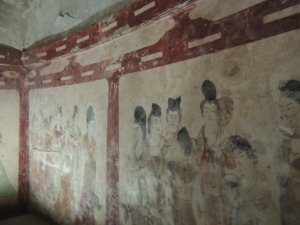 inscriptions, because her son declared that “no mere words could adequately describe her greatness.” Our tour guide commented wryly that she often felt it was a case of “if you can’t say anything nice about someone, especially your parent, then don’t say anything at all.” We visited the tomb of one of her granddaughters, Princess Yongtai, who was put to death at age 17 (supposedly accused of witchcraft by a close friend of the Empress), but then was posthumously given the title of Princess and buried with the rest of royal family. Her tomb had some wonderful paintings on the walls leading to the central sarcophagus, along with an exhibit of the pottery and figurines that were buried with her. The tombs were about 35 miles northwest of Xian in the hills, in a part of Shaanxi that was starting to look like my preconceived notions of the Chinese countryside — small homes in villages crowded together, small plots of gardens, dirt roads. The areas around the tombs are built for tourists — paved walkways, shops (of course), small eateries, etc — but the little town itself would qualify as “sleepy”. No traffic lights (although, in China, who pays attention to traffic lights!), which made crossing and turning from a four lane road to a four lane road an exercise in faith.
inscriptions, because her son declared that “no mere words could adequately describe her greatness.” Our tour guide commented wryly that she often felt it was a case of “if you can’t say anything nice about someone, especially your parent, then don’t say anything at all.” We visited the tomb of one of her granddaughters, Princess Yongtai, who was put to death at age 17 (supposedly accused of witchcraft by a close friend of the Empress), but then was posthumously given the title of Princess and buried with the rest of royal family. Her tomb had some wonderful paintings on the walls leading to the central sarcophagus, along with an exhibit of the pottery and figurines that were buried with her. The tombs were about 35 miles northwest of Xian in the hills, in a part of Shaanxi that was starting to look like my preconceived notions of the Chinese countryside — small homes in villages crowded together, small plots of gardens, dirt roads. The areas around the tombs are built for tourists — paved walkways, shops (of course), small eateries, etc — but the little town itself would qualify as “sleepy”. No traffic lights (although, in China, who pays attention to traffic lights!), which made crossing and turning from a four lane road to a four lane road an exercise in faith.
We flew back to Shanghai late Sunday evening on a flight that was, thank goodness, on time. Ever wonder what the snacks are like on a domestic Chinese airline? Well, let’s see — there’s a roll, reasonably fresh. There’s a small cup of lukewarm water (remember, no ice), a package of dried peas (which tasted like dusty dried up peas might be expected to taste), a package of two small cucumbers, and a small slice of cake.
Great trip — I’m glad we had an opportunity to go!



